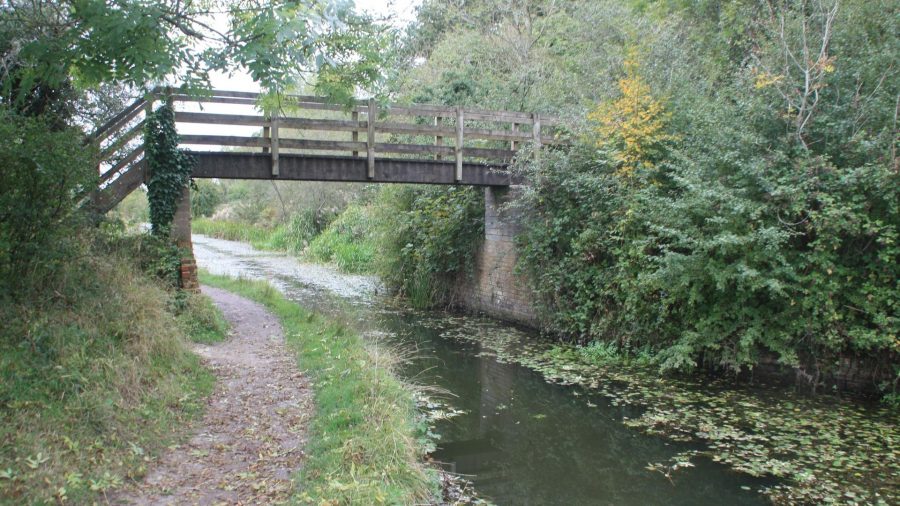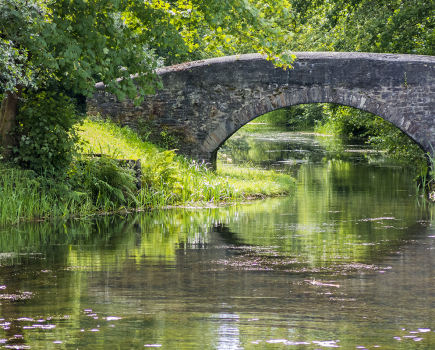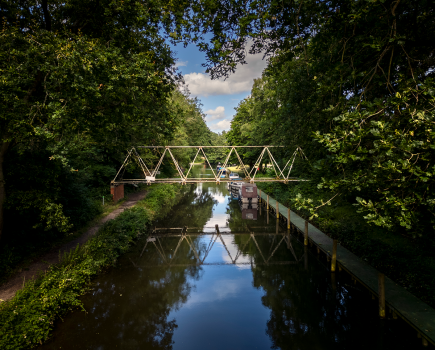In the 15 years since our last full review of one of the Wilts & Berks Canal, things have begun to get more connected on this tricky waterway restoration project, as Martin Ludgate discovers

The Wilts & Berks and North Wilts canals – planned diversions shown in red
“Increasingly, physical progress on the ground, coupled to some more strategic planning by the supporters of the restoration, means that the concept of a restored Wilts & Berks Canal at the heart of a recreated ‘Wessex waterways network’ is being taken increasingly seriously”. Those were my own words in the last general article we ran on the restoration of the Wilts & Berks – and several things about them struck me.
The first thing that struck me was how long it is since I wrote them – yes, we’ve run articles about individual Wilts & Berks projects, such as the first section of new canal built as part of the housing development scheme for south Swindon (about which more later); the volunteer restoration of the Pewsham to Melksham length; and a set of rather eye-catching graphics depicting a possible new route through Swindon running along the middle of some of the town’s streets. But after 15 years we’re clearly overdue for another general look at the overall situation along the 50-plus miles of Britain’s longest waterway under restoration.
The second thing was that – as so often happens – progress is slower than we had expected in 2006. I had expressed the hope (and the optimism of the Wilts & Berks Canal Trust) that the ‘work wherever you can’ ethos that’s an inevitable feature of the early days on a difficult restoration (and equally inevitably tends to result in a lot of isolated restorated structures and lengths of canal but less in the way of continuity or connectivity) would evolve into some more joined-up thinking and to longer sections of restored canal. I even talked of the possibility of sections being reopened to boats over the following ten years: from the Kennet & Avon Canal north to Melksham; from the Thames westward to Uffington; and from Swindon to Wootton Bassett – and of a move away from voluteer work to substantial external funding to pay for the work.
Unfortunately it hasn’t quite worked out that way – big funding has been hard to come by; the Trust found itself very short of funds after a restoration project suffered cost overruns meaning that it had to cut back on activities; and without wanting to dwell on such a tragedy, we shouldn’t avoid mentioning that a fatal accident sadly occurred some years ago at a work site at Pewsham.
Over those years a considerable amount of restoration work has continued at various sites on the canal, and some external funding has been attracted, but it hasn’t taken the leaps forward that we had hoped.
But looking ahead, the third thing that struck me was that although it’s been slow, as the Trust has picked itself up again we have genuinely begun to see all three of those elements in that 15-year-old quote that I began with: physical progress, strategic planning, and a restoration being taken seriously. And particularly in one of the three lengths I’d identified for ‘joined up’ restoration: the Royal Wootton Bassett (the town’s changed its name since the 2006 article) to Swindon section.
An aside: I know that many boating readers will groan at that last sentence. Yes, once again I’m reporting that a bunch of canal restorers are concentrating on re-creating an isolated section that’s a long way (in distance and possibly also in time) from being linked to the national network. But see the end of this article for news on a couple of developments elsewhere which might well see you visiting the W&B by water before too long. (Sorry, no ten-year predictions this time; I’ve learned my lesson!)
So, why the great hopes for the Royal Wootton Bassett to Swindon length? It’s largely down to two factors: Wichelstowe and Highways England.

Detail map of the Swindon area, showing the diversion needed around the south side of the town in red
But first a brief explanation of Swindon’s relationship with the canal. Basically the town’s development has obliterated some lengthy sections of the original canal – both the east-to-west main line (heading from Abingdon on the Thames to Semington on the Kennet & Avon Canal) and also the North Wilts Canal, a branch which left the main line near today’s town centre and headed north to join the Thames & Severn Canal (part of the Cotswold Canals restoration project) near Cricklade. Once you get clear of the urban area there are restorable lengths of canal heading in all three directions – north, east and west – but linking them back together won’t be easy.
Providing the west to north connection was the subject of the imaginative scheme (mentioned above) to create a new canal running down the middle of Swindon’s streets. This would begin where the currently restored length of canal ends to the west of the town centre, and run east and then north to link up with the surviving remains of the Cricklade route on the north side of the town centre.
Re-creating the west to east link would be more difficult, as more of the original route has been lost. So restoration plans envisaged a major diversion around the south side of the town: it would diverge from the original route at a new junction to the south west of swindon and run close to the M4 motorway for several miles, before heading north east and rejoining the old route to the east of Swindon. And this diversion route was protected in local planning.
The site for the junction, where the diversion route would leave the original line to the south west of Swindon, just happened to be right in the middle of an area earmarked for a major expansion of Swindon’s residential areas onto formerly agricultural land – christened ‘Wichelstowe’. And in an important victory for the canal restoration (not to mention a precedent for other developments elsewhere), Swindon’s planners decided that the past and future canal lines would not only be protected when the new housing was built, but that canal sections would actually be created as part of the developments.

They might not look it but these houses in East Wichel are new, as is the length of canal in front of them – it forms part of the canal’s diversion around Swindon

New lock and road bridge built as part of the East Wichel length of canal
The first of these was East Wichel, and includes a new lock (the diversion will need to gain height to get around Swindon), three new road bridges, an aqueduct and a footbridge. The new houses have been created in a 19th century town house style: at the moment they still look suspiciously new, but give them another decade and it won’t be obvious to the untrained eye that both the canal and the houses were built in the 21st century.
An aside: the houses might not be to everyone’s taste, and indeed there are debates to be had about the rights and wrongs of building large new developments on greenfield sites at all; on the other hand, when presented with a choice between new developments with a canal and new developments without a canal, it’s not such a difficult decision for canal restoration groups which of the available options to support…
Since then, a further section of Wichelstowe has been taking place alongside a section of the original route. In this case the new buildings (including a pub and a supermarket) are in modern style, but once again, several new road bridges have been built to fully navigable standard, and this length is home to a WBCT trip-boat operation. Further phases of Wichelstowe in the coming years will create the ‘missing link’ sections of canal and new junction to connect this length to the East Wichel part.

Restored section of the original canal (with moored trip-boat) in Wichelstowe
But extending navigation further west from the new junction runs into a serious problem: the M4 crosses the canal with no bridge. In fairness, nobody had even proposed restoring the canal when the motorway was being built in the late 1960s, so it’s not unreasonable that they didn’t provide a bridge. But that’s where Highways England comes in…
As reported in our news pages in recent issues, the Cotswold Canals restoration benefited to the tune of £4m from a Highways England fund set up specifically to provide public funding to remediate environmental damage caused by national road network construction in the past. The cash paid for two new bridges and associated works to enable the Stroudwater Navigation to be reopened where the A38 roundabout at Whitminster was built on the route. It will form an important part of the Lottery-supported Cotswold Canals Connected project which should see boats cruising up the western link ten miles from Saul to Brimscombe in three years’ time.

New bridge to carry the diverted Wharf Road over the restored canal
Spurred on by this success, the Wilts & Berks Canal Trust and its partners put in for the next round of HE funding – and have been awarded an initial £42,000 for feasibility studies into providing a canal crossing for the M4. They’re hopeful that this will be followed shortly by agreement of “a six figure sum” for the detailed design – and that that will then lead to a grant for the full cost of building the bridge – with construction to take place around 2023-24. And it won’t just be a bridge – on the south side it will cross Wharf Road (which is being diverted as part of road alterations to provide road access to the next stage of Wichelstowe) and reach as far as the next road blockage at Hay Lane.
The money isn’t in the bag yet, but there are grounds for optimism: in particular, the new bridge to carry the diverted Wharf Road across the canal has already been built by Swindon Council. Would they have done that if they hadn’t believed that there was a good chance of the motorway bridge being funded?
These works, together with the length of canal being built under the next stage of Wichelstowe, will give the canal the only motorway crossing needed on its entire length; triple the length available for navigation in Swindon; and get it half way to Royal Wootton Bassett. And getting the other half of the way there won’t be anything like as tricky.

Unusual canal-related feature of a new waterside pub in Wichelstowe
A short section running alongside a garden centre will need to be reinstated, but then we’re into the Studley Grange section, restored with support from a funding grant several years ago. Yes, this was the section whose costs threatened to run the Trust out of cash, but now it’s complete, in water, an attractive walk and a haven for wildlife. And immediately beyond that is the site of the missing Chaddington Lane Bridge, whose replacement has already been designed. It hasn’t yet been funded, but the Trust feels that bids for projects like this would have a good chance of succeeding off the back of a positive M4 bridge decision.
And just beyond that is Chaddington Lock, restored 20 years ago by volunteers including the visiting Waterway Recovery Group and other mobile teams (I laid a fair few bricks there myself), and a good example of the way that these projects from the early ‘work where you can’ days all help towards the eventual reopening. It leads to a restored length which (apart from a short filled-in length across a farm field) leads all the way into Royal Wootton Bassett, and gives the canal west of Swindon a ‘proper’ destination.

Local people watching the wildlife on the restored length of the original canal leading into Swindon
So that’s the west of Swindon; what about the east? For the longer term, Swindon is also looking to expand into new residential areas on its east side – and this could help the canal too. Known as the ‘New Eastern Villages’, these planned developments surround the eastern end of the proposed canal diversion around Swindon, and here too the canal’s protection in local planning means that sections of the route would be likely to be built as part of the housing schemes.
So far we’ve concentrated on the central sections of the canal around Swindon. There’s a long way to go before these will be anywhere near linking up with any of the neighbouring waterways. But earlier I promised you some news on the possibility of cruising from the national network onto a couple of lengths of the W&B not too far into the future. And these relate to both the eastern and western extremities of the canal…

The restored Studley Grange length between Swindon and Royal Wootton Bassett
Firstly, just recently there’s been news of a major domestic water supply scheme which could deliver several miles at the eastern end. A proposed large new reservoir would block the canal’s original route south west of Abingdon, but the plan is that as part of the construction works a canal diversion around the reservoir would be built. Not only that, but the reservoir’s emergency draw-down channel (required in case it needs emptying in an emergency) would be constructed in the form of a canal channel which would provide the easternmost few miles of restored canal, bypass the part of the old route that has disappeared under Abingdon, link up with a short length of new canal (including the junction with the Thames) created by volunteers in 2006, and open up navigation for boats from the Thames.
There is no decision yet on whether the reservoir will be built (and again, it’s a controversial plan, but one where restoration groups will tend to take the view that their role is to fight for ‘reservoir plus canal’ rather than ‘reservoir without canal’), but it recently made it onto a shortlist of schemes to be taken forward for more development.
Heading further west from Royal Wootton Bassett there are grounds for optimism for reopenings too. Volunteer work continues at Pewsham Locks, in the Lacock area, and on a recently acquired length of canal route heading down towards Melksham – but it’s from Melksham onwards that there’s hope of getting a link to the navigable network.
The final section of the original canal, running through Melksham to reach the Kennet & Avon has – like those through Swindon and Abingdon – been lost under 100 years of the town’s development. So once again a new route is planned, and once again it takes a radically different course: striking off north westwards from the Kennet & Avon and descending via new locks to enter the River Avon. This will be made navigable (by the addition of one shallow weir and a new lock) through the town centre, before the canal leaves via a new flight of locks north of the town and rejoins the old route.

Chaddington Lock, restored 20 years ago, awaits the boats
There have long been plans to build this as part of another residential development, with optimism that the housing costruction work will include building the canal – but it’s been held up by some protracted discussion with the Environment Agency regarding permissions. WBCT is now hopeful that an agreement is close, and the prospect of cruising from the K&A to Melksham’s riverside is not too distant.
That’s a brief canter through just some parts of a very long canal – and we haven’t even touched on the northern branch to Cricklade, where several individual restoration projects have been completed although we don’t have any big news just yet. But hopefully I’ve shown that despite the inevitably slow progress of such a difficult project, perhaps I wasn’t too far wrong in 2006 when I spoke of strategic planning, the restoration concept being taken seriously, and some actual progress on the ground.
Image(s) provided by:
Martin Ludgate






